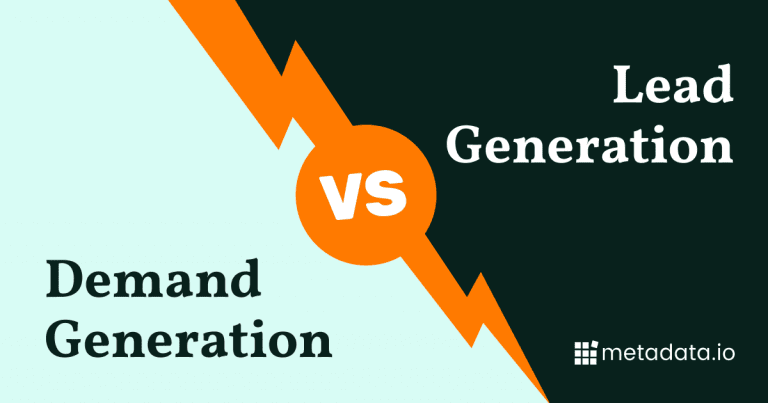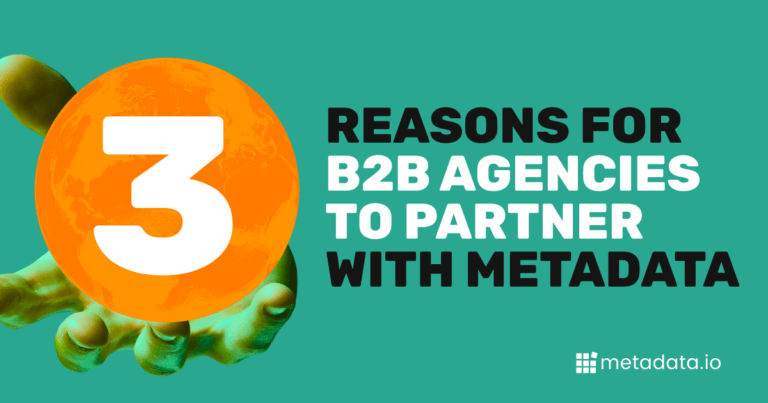There’s No ‘Or’ in Marketing: Why You Should Blend ABM and Demand Gen
Account-based marketing isn’t exactly a shiny new toy, but the way ABM platforms talk about it could’ve fooled us both.
And don’t get me started on ABM platforms defining what ABM is based on their products’ capabilities.
The past few years, we’ve seen a shift toward favoring account-based activities in B2B marketing—and for good reason.
ABM offers the opportunity to connect (or reconnect) with your target accounts, scaling and personalizing as you go.
But some have swung the pendulum a bit too far, trading in proven demand generation activities for an all account-based, all-the-time mindset.
Marketers taking on ABM like a college kid buying up AMC stock may not realize:
- How critical alignment and coordination between sales and marketing is. I know, I know, everybody talks about sales and marketing alignment. But there’s a reason: your ABM programs won’t amount to anything if you’re coming up with and executing them alone.
- Their average deal size may not warrant an ABM approach. If the average deal size is less than $20k, it probably doesn’t make much sense for you to go all-in on ABM.
- How expensive ABM can be. I’m talking content creation, program spend, direct mail…this all adds up really quickly. And many companies don’t realize what they need to get legit ABM programs off the ground.
I’m here to set the record straight: ABM is just one piece, not the end-all-be-all, of B2B marketing.
This is part 1 of our ABM/demand gen series. In this first article, I’m starting at the 30k foot level to look at why most companies should take a blended approach to ABM and demand gen. For most of the series, I’ll focus on the ground level: targeting, setting up campaigns and how to measure success. Finally, I’ll pull back out for some perspective on when ABM isn’t the right call.
30,000 feet: ABM and demand gen
What am I talking about, here?
Plenty of B2B marketers are going strong with proven demand gen tactics and focused ABM campaigns.
But some enthusiastic marketing teams have latched onto an account-based approach, leaving direct response and performance marketing behind as the pendulum swings.
Others have confused ‘demand gen’ with a shotgun approach to marketing, resulting in more leads that don’t ever convert to revenue.
I’m not here to sell ABM short—it’s an incredible way to engage with target accounts.
But here’s the thing: you don’t need to choose between ABM or demand generation (or anything else, really).
Plenty of marketers think you have to choose one or the other, as if demand gen and ABM are mutually exclusive.
But the best B2B marketers use both demand gen and ABM at the same time.
You can (and should) run targeted demand gen programs for your ideal customer profile, even if you have ABM in place, too.
This series will give you, the marketer, a framework to think through how ABM and demand generation fit together in your own company and specific strategies to get better at both.
Long story, short: ABM is one of several marketing tactics you need for a well-rounded B2B marketing program—and ABM platforms aren’t the cure all you might think they are.
If you haven’t dipped your toes in the ABM water yet, take a breath (no FOMO here). ABM isn’t for everyone.
If you’re in over your head with the account-based approach, let’s get you back to safer more innovative waters.
Running legit demand gen campaigns will help you hit your revenue numbers.
10,000 feet: Where marketing gets mixed up
I see marketing teams make many of the same mistakes as they grow the team, expand to new markets, and take on new tech to support growth and get the message out.
The most common pitfalls I see include:
- Thinking technology will solve a marketing problem. Adding an ABM platform to your stack doesn’t mean magically fix your messaging, just like downloading Calm won’t automatically increase your zen on a Tuesday morning.
- Swinging too far in either other direction. Some marketing teams are either all-in on demand gen or all-in on ABM. You gotta find the right balance for your company and target audience.
- Mixing up the intention of ABM and demand gen. Demand gen doesn’t mean take a shotgun approach with your bad marketing. ABM doesn’t mean forget about accounts that meet your ICP but didn’t make your target account list.
- Getting stuck using one-trick pony platforms. ABM platforms can help you set up effective, account-based campaigns, but they can’t scale other demand gen campaigns to fill the rest of your funnel with new prospects.
While I recommend a mix of both demand gen and ABM campaigns, most marketing teams will end up leaning one way or the other.
How do you know which to use, and when?
ABM gets me in front of my ideal customer. Why’s that so bad?
Short answer: it’s not.
Slightly longer answer: it’s not, but true ABM should focus solely on your top tier accounts and high value deals.
The smaller your deals, the more volume you need so your GTM strategy will rely more on demand gen tactics. They’re scalable and typically cheaper.
You can use demand gen to:
- Target companies and prospects that still meet your Ideal Customer Profile
- Focus on educating the market on big macro changes
- Make sure you’re not leaving good revenue on the table
Side note: once you start to build more awareness, you can start to run more direct-response campaigns.
Demand gen gets me lots of qualified leads. Why do I need ABM?
In a phrase, the larger and more complex your deals, the more your GTM strategy will rely on ABM.
You can use ABM to:
- Focus on the right accounts where you are most likely to win
- Provide much more personalized experiences for your buyers
- Improve your coordination across Sales and Marketing (IF it’s done well)
Side note: depending on where the account is in your funnel (open opp vs. no open opp) it may not make sense to run direct-response campaigns at all, and instead focus on a more personal touch with ABM.
Ground level: What to do now
I’ll be going deep in this series, but I can’t let you go without something a bit more tangible after all that naysaying.
How do you get started if you’re currently only doing demand gen or ABM?
So you’ve swung all the way to ABM. What now?
You can double down on the efficiency of your account-based campaigns and use the targeted account lists to run better demand gen campaigns down the line.
- Review your target account list with your sales team. Ask some simple questions to make sure you’re prioritizing the right accounts. How did you come up with the list? Did everyone agree on the list? Which criteria did you use, and why? Is it all firmographic, or do you use technographic and intent data?
- Review who you’re targeting within each account. Again, take stock of how you’re reaching (or not reaching) your tier 1 accounts. Are you only targeting the decision makers, or have you added contacts for the rest of the buying committee? Which channels are you targeting them on—and why those channels?
- Turn your account list into a legit Ideal Customer Profile. What are the common attributes of your target accounts? Which job titles make up the buying committee at your target accounts? If your lists are laser-focused on the most promising opportunities, you’ll end up with much better targeting for your demand gen campaigns.
So you’re still all-in on demand gen. What now?
Starting an account-based marketing approach from scratch can seem more than a little overwhelming. But, as long as you don’t overcomplicate it, ABM can complement your demand gen campaigns and lead to bigger opportunities.
- Don’t go “whole hog” right away, start small. Start by meeting with Sales, Product and Customer Success. Find consistencies across your best accounts so you can see where you have the strongest value prop, case studies and social proof. It can be as simple and small as 10 enterprise accounts, but whatever you do, don’t just pull a list of nice-to-have logos out of a hat.
- Figure out the right approach to get started. ABM isn’t just one thing—there are one-to-one tactics, one-to-few tactics, and one-to-many tactics. Depending on how many target accounts you’re including in your pilot and the internal resources you have (think people and budget), pick the approach that makes the most sense for you. The more personalized your ABM approach is, the bigger lift will be for your team. One-to-one personalized content for your target accounts sounds great in theory, until you see how unrealistic it is for a small team with limited budget.
Tl;dr — whether you’re all-in on ABM or still heads down in demand gen, you’ll likely get a lot of value by taking a blended ABM + demand gen approach. Just make sure you’re using the right tools, testing and collecting feedback, and iterating as you go.


